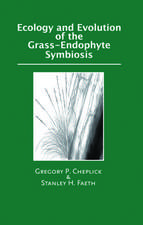Ecophysiology of Desert Arthropods and Reptiles: Adaptations of Desert Organisms
Autor John L. Cloudsley-Thompsonen Limba Engleză Paperback – 13 dec 2011
Din seria Adaptations of Desert Organisms
- 18%
 Preț: 954.14 lei
Preț: 954.14 lei - 18%
 Preț: 948.29 lei
Preț: 948.29 lei - 18%
 Preț: 945.92 lei
Preț: 945.92 lei - 18%
 Preț: 947.35 lei
Preț: 947.35 lei - 18%
 Preț: 1384.44 lei
Preț: 1384.44 lei - 18%
 Preț: 946.10 lei
Preț: 946.10 lei - 18%
 Preț: 1212.68 lei
Preț: 1212.68 lei - 18%
 Preț: 953.82 lei
Preț: 953.82 lei - 15%
 Preț: 632.70 lei
Preț: 632.70 lei - 15%
 Preț: 635.31 lei
Preț: 635.31 lei - 15%
 Preț: 639.25 lei
Preț: 639.25 lei - 15%
 Preț: 639.73 lei
Preț: 639.73 lei -
 Preț: 382.57 lei
Preț: 382.57 lei - 15%
 Preț: 636.80 lei
Preț: 636.80 lei - 15%
 Preț: 640.24 lei
Preț: 640.24 lei - 15%
 Preț: 641.03 lei
Preț: 641.03 lei - 15%
 Preț: 632.37 lei
Preț: 632.37 lei - 15%
 Preț: 637.28 lei
Preț: 637.28 lei -
 Preț: 378.92 lei
Preț: 378.92 lei - 15%
 Preț: 633.53 lei
Preț: 633.53 lei - 15%
 Preț: 693.71 lei
Preț: 693.71 lei - 15%
 Preț: 636.45 lei
Preț: 636.45 lei - 15%
 Preț: 641.53 lei
Preț: 641.53 lei -
 Preț: 388.34 lei
Preț: 388.34 lei -
 Preț: 395.63 lei
Preț: 395.63 lei
Preț: 636.45 lei
Preț vechi: 748.76 lei
-15% Nou
Puncte Express: 955
Preț estimativ în valută:
121.78€ • 132.70$ • 102.62£
121.78€ • 132.70$ • 102.62£
Carte tipărită la comandă
Livrare economică 23 aprilie-07 mai
Preluare comenzi: 021 569.72.76
Specificații
ISBN-13: 9783642753398
ISBN-10: 3642753396
Pagini: 216
Ilustrații: X, 203 p.
Dimensiuni: 155 x 235 x 11 mm
Greutate: 0.31 kg
Ediția:Softcover reprint of the original 1st ed. 1991
Editura: Springer Berlin, Heidelberg
Colecția Springer
Seria Adaptations of Desert Organisms
Locul publicării:Berlin, Heidelberg, Germany
ISBN-10: 3642753396
Pagini: 216
Ilustrații: X, 203 p.
Dimensiuni: 155 x 235 x 11 mm
Greutate: 0.31 kg
Ediția:Softcover reprint of the original 1st ed. 1991
Editura: Springer Berlin, Heidelberg
Colecția Springer
Seria Adaptations of Desert Organisms
Locul publicării:Berlin, Heidelberg, Germany
Public țintă
ResearchCuprins
1 Introduction.- 2 The Deserts of the World and Their Faunas.- 2.1 Classification of Deserts.- 2.2 Precipitation and Moisture.- 2.3 Exposure.- 2.4 Parallel Evolution, Convergence and Ecological Equivalents.- 2.5 Energy Flow.- 2.6 Trophic Level Patterns of Process-Functioning.- 2.7 Moisture-Associated Patterns of Process-Functioning.- 2.8 Field Metabolic Rates.- 2.9 Conclusions.- 3 Avoidance of Environmental Extremes.- 3.1 Introduction.- 3.2 Desert Microclimates.- 3.3 Circadian Locomotory Rhythms.- 3.4 Seasonal Rhythms in Locomotory Activity.- 3.5 Social Behaviour.- 3.6 Conclusions.- 4 Thermal Regulation and Control.- 4.1 Introduction.- 4.2 Behavioural Thermoregulation.- 4.3 Thermal Tolerance.- 4.4 Thermal Control.- 4.5 Responses to Ultraviolet Radiation.- 4.6 The Mechanism of Heat Death.- 4.7 Conclusions.- 5 Water Balance and Nitrogenous Excretion.- 5.1 Introduction.- 5.2 Evaporative Water Loss.- 5.3 Excretory Water Loss.- 5.4 Osmoregulation.- 5.5 Behavioural Regulation of Water Loss.- 5.6 Water Uptake.- 5.7 Conclusions.- 6 Seasonal Activity and Phenology.- 6.1 Introduction.- 6.2 The Arthropods of Temporary Rain Pools.- 6.3 Flooding.- 6.4 Diapause, Aestivation and Seasonal Patterns of Activity.- 6.5 Phenology of Reproduction.- 6.6 Conclusions.- 7 Adaptations for Burrowing in Sand, Avoidance of Enemies and Defence.- 7.1 Introduction.- 7.2 Burrowing.- 7.3 Sand Swimming and Sand Running.- 7.4 Adaptive Colouration.- 7.5 Defences.- 7.6 Conclusions.- 8 Interspecific Relationships, Feeding Specializations and Species Diversity.- 8.1 Introduction.- 8.2 Food Selection and Consumption.- 8.3 Feeding Specializations.- 8.4 Species Diversity and Competition.- 8.5 Interacting Factors.- 8.6 Conclusions.- 9 Final Conclusions.- References.














